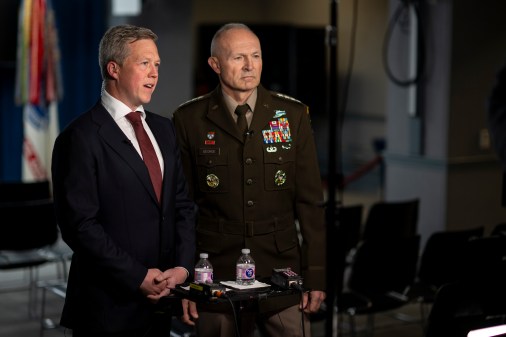Army acquisition chief anticipates funding boost for FUZE program

The Army’s top acquisition official told DefenseScoop that he expects to see further growth in resources for the service’s FUZE initiative.
FUZE, which was announced last month by Army Secretary Dan Driscoll, combines elements of multiple technology innovation programs — including the xTech, Small Business Innovation Research and Small Business Technology Transfer (SBIR/STTR), ManTech, and Technology Maturation Initiative efforts — under a more integrated framework to accelerate the delivery of new capabilities to soldiers, according to the service.
Driscoll has described it as the Army’s “new cradle-to-grave capital funding model.”
“It will identify promising startups, quickly fund them and get minimally viable products to soldiers in weeks. FUZE, like VC firms, will be successful because we will work with agile, innovative, hungry startups that live on the very edge of innovation,” Driscoll said last week at the annual AUSA conference.
“Our goal with FUZE is to contract with startups that have never, ever worked with the United States Army before in just 60 to 70 days. For companies we have worked with that have prototype-level entries, we want to contract in 10 and start soldier iterations in 30 to 45 days. We train like we fight. Acquisition should be no different. We wouldn’t take 10 to 12 months to sign a contract while in a fight. So, we will train our system to move fast. And soon, Ukraine won’t be the only Silicon Valley of warfare. FUZE finds and grows capabilities and then feeds them into our broader acquisition system,” he added.
The Army has already aligned $750 million to this model under FUZE, according to Driscoll. Next year, it plans to raise that slightly to $765 million.
Brent Ingraham, the new assistant secretary of the Army for acquisition, logistics and technology, said he anticipates that funding levels for those efforts will be higher in subsequent years.
“I actually see it going up as we continue to improve this model. So, you know, the FUZE initiative falls within the ASA(ALT) family, right within my organization,” Ingraham said during an interview on the sidelines of the AUSA conference. “That’s made up of things like SBIR/STTR, you think of those processes, our Tech Maturation Initiative lines. And so those are all the efforts that we’ve kind of consolidated together to really lay out this sort of xTech sort of approach.”
The Army last week announced that eight vendors won a new iteration of the xTech Disrupt competition, where vendors pitch their innovations to the Army and other judges. The list of winners and their respective technologies included:
R2 Wireless — Passive RF detection, classification, geolocation and tracking.
Mesodyne — Fuel-agnostic, ultra-portable, quiet generator (capable of utilizing gasoline, diesel, JP-5. JP-8, etc.), reducing the warfighter’s battery load by hundreds of pounds.
Auterion — Skynode all-in-one flight controller and mission computer that powers autonomous robots with AuterionOS, transforming them into a networked, AI-enabled system.
Nine Five North — Unmanned aerial system with ground-penetrating radar for mine and unexploded ordnance sensing and clearing.
Orion Edge — Low SWAP-C, fully autonomous RF Control for low probability of detection jamming and disruption of adversary navigation and digital messages.
Inergy — Portable energy storage at the edge (stackable batteries).
Aurelius Systems — Archimedes, a low SWAP laser weapon system for counter-drone defense, that’s capable of delivering effects at less than a dollar per shot.
Modalic — Drone mothership capable of carrying several small UAS longer distances, enabling longer-range swarm systems.
“It was incredible today to see hundreds of companies want to pitch their capabilities. You have users questioning them, doing their Shark Tank-style approach that ultimately led to eight companies today getting some awards. Those eight companies in 20 days will be in the field with their kit. That was part of it — are you really ready to go? … They’ll get direct feedback from those users on where they need to go and improve,” Ingraham told DefenseScoop.
“And hopefully there is some of that great tech out there that a couple things happen. One is that private industry, private equity and capital invest in those companies because they’ve got a great technology. So they help them grow as a company. At the same time, if it’s a kit that works great for the Army, we can scale it quickly. We’ve got all the acquisition authorities and pieces we need to be able to scale quickly, ensuring that, again, with a focus on deliveries, that we can scale them to a point where they can truly deliver capability,” he said.
DefenseScoop asked Ingraham if he anticipates that FUZE will grow to become a multibillion-dollar initiative.
“We’ll see, right?” he replied. “I think some of the things we’re working through is, you know, they may have a great technology, [but] do we give them enough focus to ensure that it works with also ensuring that we deliver on a mission kill chain?”
Ingraham described mission kill chains from the perspective of a portfolio management approach, including a variety of weapon systems and communications capabilities that soldiers can use to “put effects on target, downrange.”
“All those sorts of things lead to … some effect on the battlefield that you’re trying to do. Portfolio acquisition executives, like CEOs, will have to manage across that. And so ensuring that … we find where those gaps are across that kill chain is where we’ll need to make sure that those xTech efforts are really trying to plug in to fill those gaps, or help us think of a new capability that may be … available that can still deliver that effect, but do it differently. And so part of that will be, how much is it a separate issue, versus as we stand up portfolio acquisition executives, how they mesh and work together?” Ingraham said.






